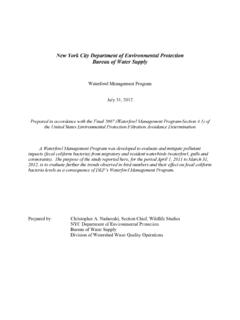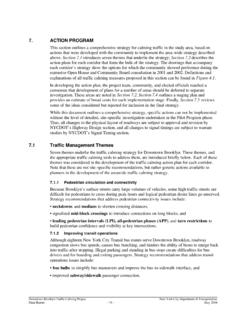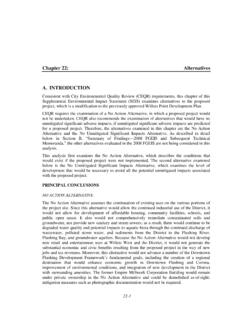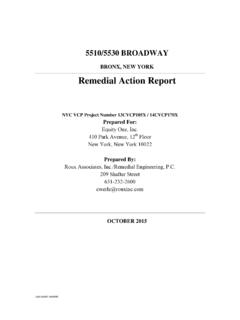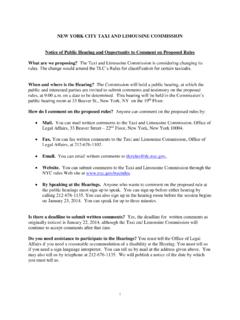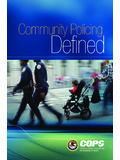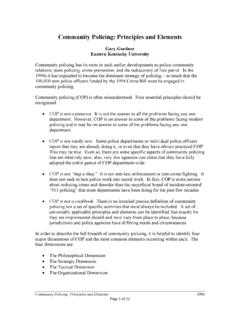Transcription of THE NYPD PLAN OF ACTION AND THE NEIGHBORHOOD …
1 THE NYPD plan OF ACTION AND THE. NEIGHBORHOOD policing plan : A Realistic Framework for Connecting Police and Communities By William J. Bratton New York City Police Commissioner If I count my years as a military police offi- cer in Vietnam, I have spent nearly 50 years We have an opportunity in the policing profession. I have been part to achieve what has, until now, of, or witness to, just about every twist and turn in policing philosophies and methodol- been an elusive goal: we can ogy from early community policing exper- iments in the Boston Police Department in establish a truly realistic and the 1970s, to the first large-scale application of Broken Windows policing in the New workable community- policing York City subway in the early 1990s, to the plan across the neighborhoods development of Compstat in the NYPD in 1994, to the integration of advanced technol- of a large city.. ogy into policing and counter-terrorist work in Los Angeles in the 2000s, to the current THE NYPD plan OF ACTION .
2 Challenges in New York City. I view what we are trying to do in New York today as the With our plan of ACTION , the NYPD is under- culmination of my long career and an oppor- taking a series of strategic changes in how it tunity to put all that I have learned to work performs its critical police mission. Taken to- in a city I love and have long considered my gether, these changes mark a significant de- home. parture from past practice. The Department will define and implement new initiatives in five key areas: I have been a change agent in all six police Tactics A NEIGHBORHOOD - policing plan departments I have been privileged to lead. that is rooted in local communities and In every case, I have used the vehicle of a plan tied to local concerns. of ACTION to jumpstart change and reform in the department in question. In these plans, I Technology A revolution in NYPD. have tried to define what was needed in the technology, bringing its full capabilities way of resources, staffing, technology, and to police officers in the field.
3 Political will to move from each department's Training Field training for recruits current state toward a more motivated, more and recurring training for veterans, productive and more effective organization. imparting the skills to manage the I think we can do it again in the NYPD of human encounters that are the 2015; and furthermore, I think we have an fundamental business of street policing . opportunity to achieve what has, until now, been an elusive goal: we can establish a truly Terrorism Strengthened investigative realistic and workable community- policing and enforcement efforts with federal, plan across the neighborhoods of a large city. state and local partners, as well as significantly enhanced critical-incident capabilities in response to evolving overseas conditions that have altered the local threat picture. THE NYPD plan OF ACTION AND THE NEIGHBORHOOD policing plan 1. Trust A compact with both the communities and the cops to deal fairly We have known since the 1960s with each other, with people stopped or that cops running from call to arrested and, just as important, with the officer who has committed an error call simply do not have the time of judgment, not a criminal act.
4 To engage with communities and individual residents in any mean- The NYPD calls these categories the Five Ts. They form the framework of our emerg- ingful or problem-solving way.. ing plan to make the city safer than ever before, and to so do by reaching across the Since the advent of 911 emergency sys- divide that still persists in some minority tems, and the attendant demand for police communities. It is a plan to break down, once services in response to 911 calls, police agen- and for all, the barriers between two parties cies have faced the challenge of staying con- who should be natural allies: the police and nected to communities and neighborhoods. the people they serve. We have known since the 1960s that cops running from call to call simply do not have COMMUNITY policing AND ITS the time to engage with communities and DISCONTENTS individual residents in any meaningful or Since my early days in this business I problem-solving way.
5 The situation is com- have believed in the vision of community pounded by the fact that officers assigned policing of cops and community members to answering calls get in the habit of doing working as a seamless team, of cops really that and nothing else. They become, in effect, knowing communities, of community mem- call-answering machines, their schedules set bers really knowing their cops. But I have and their workdays defined by the radio and also recognized the challenges inherent the next call. in operationalizing the community polic- ing idea, especially in a large city. We don't want to deceive ourselves into believing that On the other hand, efforts to establish sep- the department as a whole is engaging with arate community policing staffs within police communities and neighborhoods when just departments, to perform the community con- a small part of the team has been assigned nection functions that the patrol cops do not, to specialize in community work.
6 The NYPD have frequently foundered and failed. The has an excellent staff of community-focused first problem that arises is a bifurcation of officers working with everything from youth the police force and consequent resentments programs to block associations to crime pre- between the cops who are doing the calls- vention, and they have done important work for-service work and the seemingly favored in keeping the department connected with group who are building community relations the neighborhoods we serve. They have been but have no apparent steady workload. The a bridge between the community and the patrol cops think that the community polic- police. But bridging the police/community ing officers aren't really working and they divide is not enough. We want to close it. To don't become any more attuned to the com- do so, we have to undertake community polic- munity themselves because they aren't the ing on a far larger and more comprehensive ones interacting with community members.
7 Scale. And at the heart of the plan must be In addition, the community officers have of- the patrol officers themselves, the cops who ten been too few in number to establish any answer calls and patrol the streets each day. kind of critical mass or around-the-clock presence, or to make inroads with more than a small portion of a typical precinct's many parts. Precinct-based community affairs is THE NYPD plan OF ACTION AND THE NEIGHBORHOOD policing plan 2. composed of two or three cops working eight- can only achieve this by completely revamp- hour shifts, and they scarcely make a dent in ing how patrol is done in the precincts and the problem. All of these shortcomings were establishing an entirely new model of how to apparent in the Community Police Officer staff and execute the patrol function. Chief on Patrol or C-POP program that the NYPD O'Neill's plan has a number of salient fea- attempted to implement in the early 1990s, tures: and the program gained little real traction or purchase.
8 The proposed plan is structured to solve the central problem The second problem is that young officers assigned to the community function may in implementing the community not have skills to accomplish their mandate. policing ideal: It keeps our cops Without training or a genuine support sys- tem to help them take on these complex roles, engaged with police work while they can't be expected to form community al- liances and address entrenched community allowing them to embed in our problems. Yet generally, where these kinds of programs have been tried, that is exactly communities as part of a team what has happened, with the cops thrust into that works together to improve social mediation and NEIGHBORHOOD organi- zation roles for which they are unprepared. safety and quality of life Disconnected from calls for service, these community officers also tend to lose some of for everyone.
9 Their edge, as they stop being first respond- ers and crime fighters and become a kind of Division of each precinct into four to hybrid: part police officer, part social worker. five fully staffed sectors. Currently precincts have as many as eight THE NEIGHBORHOOD policing plan to ten sectors, but they are rarely if ever individually staffed, and Chief of Department James O'Neill has de- depending on the available staffing, veloped a NEIGHBORHOOD policing plan that I a single patrol car may be covering believe to be the first truly realistic and com- two to three sectors on a given shift. prehensive approach to achieving the com- munity policing goal in a large organization. Sector boundaries that conform as In my estimation it addresses every one of much as possible to actual neighbor- the problems and failings I outlined above, hood borders, establishing a sense of while delivering a framework for local police/ connection between the police patrol community collaboration.
10 The proposed plan team and the local population. is structured to solve the central problem in implementing the community policing ideal: It Permanent assignment of a two-offi- keeps our cops engaged with police work while cer patrol car to each sector on each allowing them to embed in our communities as shift, and on some days, two such part of a team that works together to improve cars to manage the workload. Un- safety and quality of life for everyone. like current practice, the patrol cars will maintain sector integrity, the How do we avoid the trap of separating policing term for keeping patrol cars patrol and community functions? How do in the sectors to which they are as- we make the patrol officer who answers calls signed rather than sending them to and the community officer who engages with calls outside the sectors during the the NEIGHBORHOOD the very same person? We course of a shift.



